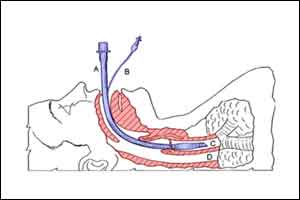- Home
- Editorial
- News
- Practice Guidelines
- Anesthesiology Guidelines
- Cancer Guidelines
- Cardiac Sciences Guidelines
- Critical Care Guidelines
- Dentistry Guidelines
- Dermatology Guidelines
- Diabetes and Endo Guidelines
- Diagnostics Guidelines
- ENT Guidelines
- Featured Practice Guidelines
- Gastroenterology Guidelines
- Geriatrics Guidelines
- Medicine Guidelines
- Nephrology Guidelines
- Neurosciences Guidelines
- Obs and Gynae Guidelines
- Ophthalmology Guidelines
- Orthopaedics Guidelines
- Paediatrics Guidelines
- Psychiatry Guidelines
- Pulmonology Guidelines
- Radiology Guidelines
- Surgery Guidelines
- Urology Guidelines
Commercial fastener better than tape for securing endotracheal tube

USA: The use of an endotracheal tube fastener for securing an endotracheal tube in critically ill adults undergoing endotracheal intubation is associated with a reduced rate of endotracheal tube dislodgement and skin breakdown compared to the use of adhesive tapes.
These are the results of a recent study published in the BMC Journal Critical Care.
There are many options available to the clinicians for securing endotracheal tubes including adhesive tapes, cotton twill, and mechanical devices. The optimal securement method of endotracheal tubes is unknown but should prevent dislodgement while minimizing complications. Janna S. Landsperger, Department of Medicine, Vanderbilt University, Nashville, USA, and colleagues evaluated the safety and efficacy of different endotracheal tube securement techniques.
For this, the researchers conducted a pragmatic, randomized controlled trial comparing the effect of adhesive tape versus endotracheal tube fastener on complications including lip ulcers, facial skin tears, endotracheal tube dislodgement, and ventilator-associated pneumonia among critically ill adults requiring intubation and mechanical ventilation for at least 24 h.
Of 500 patients randomized over a 12-month period, 162 had a duration of mechanical ventilation less than 24 h and 40 had missing outcome data, leaving 153 evaluable patients randomized to tube fastener and 145 evaluable patients randomized to adhesive tape.
The primary endpoint was a composite of any of the following: the presence of lip ulcer, endotracheal tube dislodgement (defined as moving at least 2 cm), ventilator-associated pneumonia, or facial skin tears anytime between randomization and the earlier of death or 48 h after extubation.
They found that:
- The primary endpoint occurred 13 times in 12 (7.8%) patients in the tube fastener group and 30 times in 25 (17.2%) patients in the adhesive tape group for an overall incidence of 22.0 versus 52.6 per 1000 ventilator days, respectively.
- Lip ulcers occurred in 4 (2.6%) versus 11 (7.3%) patients, or an incidence rate of 6.5 versus 19.5 per 1000 patient ventilator days in the fastener and tape groups, respectively.
- The endotracheal tube was dislodged 7 times in 6 (3.9%) patients in the tube fastener group and 16 times in 15 (10.3%) patients in the tape group, reflecting incidences of 11.9 and 28.1 per 1000 ventilator days, respectively.
- Facial skin tears were similar between the groups.
- Mechanical ventilation duration and ICU and hospital mortality did not differ.
Also Read: Radiological evaluation of airway – What an anaesthesiologist needs to know!
"In this trial involving critically ill adults, securement of an endotracheal tube with a tube fastener resulted in a lower incidence of and fewer patients experiencing lip ulcers, endotracheal tube dislodgements, or facial skin tears compared to securement with adhesive tape," concluded the authors.
For detailed study log on to https://doi.org/10.1186/s13054-019-2440-7

Disclaimer: This site is primarily intended for healthcare professionals. Any content/information on this website does not replace the advice of medical and/or health professionals and should not be construed as medical/diagnostic advice/endorsement or prescription. Use of this site is subject to our terms of use, privacy policy, advertisement policy. © 2020 Minerva Medical Treatment Pvt Ltd